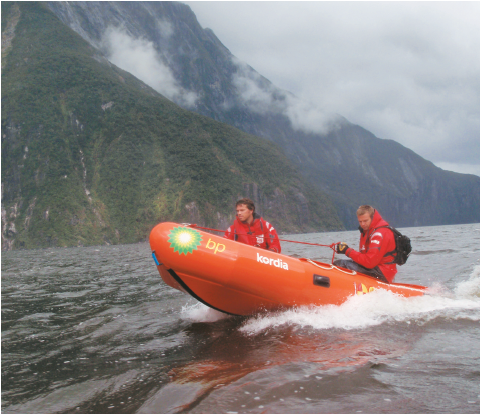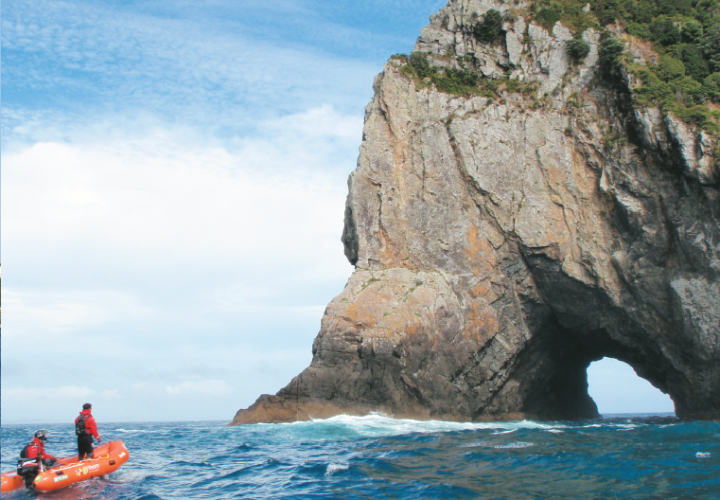As most kiwis were kicking back, enjoying their summer holidays earlier this year, a group of volunteer surf lifeguards were preparing themselves for a different kind of break – a record setting voyage that had never been attempted before.
To celebrate the centenary of surf life saving in New Zealand, the lifeguards, all men in their mid 20s, set off to circumnavigate the perimeter of the country on Wednesday, 5 January.
Undertaken in two specially modified inflatable rescue boats (IRBs), this marked the first time a full circumnavigation (North, South and Stewart Islands) of New Zealand had ever been completed in an inflatable craft less than 4m in length.
Led by Muriwai surf lifeguards Ash Matuschka and Andrew (Slim) Lancaster, the team also included Auckland-based Jason Harvey, Blake Ingram, Matt Buswell and Antony Morgan of Papamoa.
Matuschka and Lancaster came up with the idea of circumnavigating the country’s coastline after reading Bear Grylls’ (Man vs. Wild) book about his unassisted crossing of the North Atlantic Arctic Ocean in an open rigid inflatable boat.
“Slim and I sat down with the guys and discussed how we could make it happen,” said Matuschka. “It was then and there we decided as a small group of clubbies that we wanted to achieve something significant to pay tribute to the organisation’s centenary.”
The voyage took over 18 months to plan. As well as liaising with volunteers at surf life saving clubs around the country, discussing how their members could leverage and be involved with the team during their mission, the men poured hours into researching similar nautical adventures, modifying equipment, plotting their route and working out at the gym.
“Not only did the gear need to be top notch, but our bodies needed to be conditioned too. We spent four solid months strengthening our core muscles so we could take big knocks out on the water without falling to pieces,” said Matuschka. “Each team member was allocated an area of responsibility. We had to spread the load in order to cover everything off properly and efficiently while we were in the planning phase.”
The Inflatabale Journey
Originally expected to take 40 days, the 5,200km journey was completed in 34 days, with the crew touching down not only at New Zealand’s most well-known surf beaches along the way, but at some of the country’s most remote coastal locations also.
Shadowed by an on-land support team which included a reserve driver (Jason Glew), safety manager, mechanic, physiotherapist and land-based support person, there were two IRBs on the water at all times (with a driver and crewman in each) to act as each other’s safety vessel.
Communications equipment supplied by Kordia enabled people to track the team’s progress live from the moment they departed Auckland via the website www.sixsurflifeguards.org.nz.
“We’ve been told the live tracking function made people feel as though they were part of the action,” said Matuschka.
Hundreds of people watched from computers at home, work and on their mobile phones as the crews headed up the North Island’s East Coast, finishing the first of the journey’s 32 legs at Ocean Beach, Whangarei Heads.
After departing Matai Bay en route for Ahipara on the West Coast of the Far North on day three, favourable weather and surf conditions prompted the team to push further than planned. The crew ended up completing two legs in one day, travelling 438km from Matai Bay to Muriwai. The marathon effort took just under 15 hours, with the crew pulling into the beach at 9.15pm, just as the sun was setting.
Now ahead of schedule, the lifeguards continued forging their way south. Always aware the weather had the potential to stall their trip, the team wasted no time covering off the West Coast of the North Island.
Matuschka said a seamless crossing of Cook Strait put them in a good position to continue pushing down the South Island towards Fiordland.
“We knew we had to get to Fiordland as quickly as we could – that way, if the weather did pack up and prevent us from moving for a few days, at least we’d have time up our sleeves and wouldn’t fall behind.”
And that is exactly what happened.

After departing Milford Sound for Breaksea Sound, the lifeguards were forced to hunker down in a barge for two days until wild weather permitted them to continue.
“We stayed in close contact with our land-based safety manager, Andy Kent, who was monitoring the forecast for us. Together, we came up with a plan to head around to Preservation Inlet and then around to Oreti Beach [at the tip of the South Island]”.
Foveaux Strait posed no obstacles for the crew and they commenced the leg around Stewart Island – a part of the trip they had been quite worried about.
“After we’d completed the Stewart Island leg, pushing back up the East Coast was relatively painless. Each night we’d spend a solid two or three hours working on the gear to ensure it stayed in reliable working order,” said Matuschka.
Inflatable Trouble
“However, we did end up running into some difficulty as we approached Mahia. One of the boats ran over a submerged piece of plywood with an exposed nail in it. Obviously, nails and inflatable boats don’t mix too well. It completely destroyed one of the pontoons [an IRB consists of three inflatable pontoons as well as an inflatable keelson). The crew on the water that day handled it well. The IRB that hadn’t been affected towed the deflated boat behind it right through to Mahia. We swapped hulls and they continued on with that day’s leg.”

As the team continued to draw closer to their Auckland finish line, members of the support crew were involved in an unexpected rescue at a remote East Cape beach also.
Matuschka – who was off the water on an allocated rest day – was waiting with safety manager Kent in the support vehicle on the shore at Te Rangiharu Bay.
“Suddenly this guy came running up to us out of nowhere and said his girlfriend and dad needed help because they were stuck in a rip down the beach,” said Matuschka.
“Andy grabbed his fins and headed out straight away while I followed behind. The dad managed to get himself to shore so we focused on rescuing the girl. The rip was pulling hard and she was about to go under – we managed to get there just in time.
“It was only by luck we had parked up at Te Rangiharu Bay. The guys on the water had meant to travel further that day but strong northwesterlies prompted them to cut the leg short. Lucky they did.”
The centenary circumnavigation was officially completed on Monday, 7 February. Accompanied by a fleet of 15 IRBs from various Auckland surf life saving clubs, the lifeguards received a heroic welcome as they pulled back into the Viaduct Harbour.
Six men, 34 days, 5,200km travelled.
“It feels like a blur to be honest. All the planning – months and months of it – ended up culminating in an adventure of a lifetime. A circumnavigation of a country is something most people will never get to experience, and we’re all very grateful we got a chance to make it happen,” said Matuschka.
Here’s to another 100 years of surf life saving in New Zealand!





